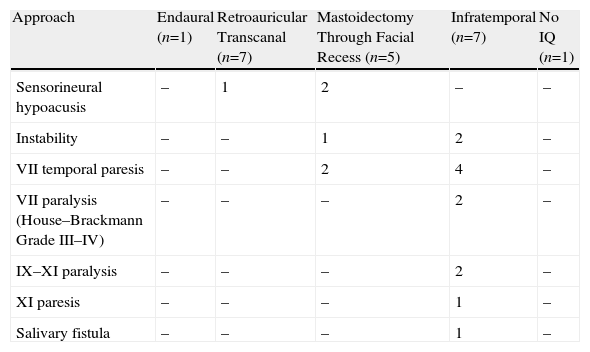Our objective was to perform a retrospective analysis of patients with jugulotympanic paragangliomas. We present the results according to the surgical approach applied in each case.
Materials and methodsThis retrospective study presents the findings in 21 patients with jugulotympanic paragangliomas who were observed and treated in our department over a 12-year period (1999–2011). We performed a general otolaryngology exam, systemic evaluation, and radiological exam. Surgical treatment was performed in 20 cases out of 21. In 1 case, treatment with stereotactic radiosurgery was carried out.
ResultsThe surgical approaches were: endaural, retroauricular transcanal, radical or modified mastoidectomy through facial recess, and infratemporal fossa approach. Preoperative embolisation was used in 12 cases. In all cases the diagnosis of paraganglioma was confirmed. The most frequent postoperative complications found were transitory palsy of the facial nerve, sensorineural hearing loss, imbalance, paralysis of the cranial nerves IX and XI, and salivary fistula. No recurrences were found after 12 years of follow-up. One case of persistence was found in the case treated with radiosurgery.
ConclusionsIn our series surgery was found to be the elective therapy for patients with paraganglioma, with no recurrences after 12 years of follow-up. Preoperative embolisation decreases surgery time and intraoperative bleeding. Stereotactic radiotherapy cannot eliminate the tumour.
El objetivo de este trabajo es realizar un estudio retrospectivo en pacientes con diagnóstico de paraganglioma temporal, analizando los resultados según la conducta terapéutica aplicada para cada caso.
Material y métodosSe incluyó a 21 pacientes con diagnóstico de paraganglioma temporal tratados en nuestro servicio entre enero de 1999 y abril de 2011. A todos se les realizó un examen otorrinolaringológico, sistémico y de imagen. En 20 casos se realizó cirugía para su exéresis y en un caso se realizó tratamiento con cirugía estereotáxica.
ResultadosSe realizó embolización preoperatoria en 12 casos. Los abordajes quirúrgicos fueron: extirpación endaural, resección transcanal tras abordaje retroauricular, mastoidectomía radical ampliada con abordaje de receso facial y abordaje infratemporal. El diagnóstico de paraganglioma fue confirmado en todos los casos. Las complicaciones postoperatorias más frecuentes fueron: paresia transitoria del VII par, hipoacusia neurosensorial, desequilibrio, parálisis del VII, parálisis del IX y el XI par y fístula salival. No se observó recidiva de enfermedad con seguimiento entre 1 y 12 años. En un caso tratado con radiocirugía persiste el tumor, estabilizado.
ConclusionesEn nuestra serie la cirugía constituye la terapia con la que se logró la resección tumoral total en todos los casos. El uso de embolización preoperatoria reduce el tiempo quirúrgico y el sangrado intraoperatorio. La radiocirugía estereotáxica no permite la desaparición tumoral y persiste la enfermedad.











